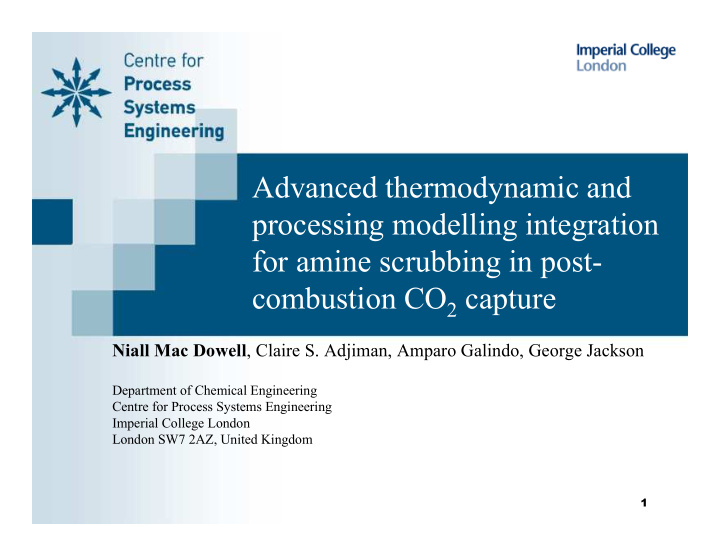



Advanced thermodynamic and processing modelling integration for amine scrubbing in post- combustion CO 2 capture Niall Mac Dowell , Claire S. Adjiman, Amparo Galindo, George Jackson Department of Chemical Engineering Centre for Process Systems Engineering Imperial College London London SW7 2AZ, United Kingdom 1
Outline Industrial relevance of complex fluids SAFT-VR : The molecular model Case study - MEA CO 2 capture process Conclusions 2
Industrial relevance of complex fluids Post-combustion capture (PCC) with amine scrubbing is seen as a useful route to reducing carbon emissions PCC is energy intensive – solvent regeneration accounts for the vast majority of costs associated with CCS , thus there is great interest in solvent design and solvent blends Detailed understanding of solvent fluid phase behaviour is vital in this endeavour Amines are complex fluids – need to be able to predict non-ideal behaviour Azeotropy Multiple vapour or liquid phases – liquid-liquid equilibrium (LLE) Sophisticated thermodynamic treatment required – cubic EoS not applicable , quuasichemical-based theories not ideal The Statistical Associating Fluid Theory for potentials of Variable Range is a suitable theory; explicitly treats non-sphericity and association contributions to the free energy , s uccessful at predicting azeotropy and LLE SAFT-VR is a free-energy EOS : fluid is characterised once all the parameters are known 3
SAFT-VR: The molecular model Molecule as chain of m tangentially HO-CH 2 -CH 2 -NH 2 bonded homologous spherical segments e of diameter σ e Segments interact via a square well e * potential of depth ε and range λ λσ H H * φ (r) H * r - ε Other Wertheim-like treatments: σ λσ σ Button and Gubbins (SAFT) 1999 Association; Avlund et al. (CPA) 2008 Off-centre association sites of strength ε HB and range K AB Gil-Villegas et al., J. Chem. Phys., 1997 4
Alkanolamines HO-(CH 2 ) i -NH 2 Detailed molecular model developed taking into account all interactions Asymmetric interactions taken into account HB HB HB HB � � � � � � � eH * * * * e H eH e H Hypothesis: MEA behaves like C 2 H 5 OH interacting with C 2 H 5 NH 2 Transfer self-association parameters from C 2 H 5 OH and C 2 H 5 NH 2 models Problem dimensionality reduced by over 50% by parameter transfer Parameter space descritised in terms of ε Disp , ε HB eH and ε HB e*H* Excellent models for MEA have been developed % Average Absolute Deviation = 2.4% e e * e H * H H * 5
6
MEA + H 2 O binary mixture Complex cross-associating mixture Asymmetric MEA model leads to many unlike-interaction parameters -NH 2 – H 2 O interaction: ε 1 HB ij -OH – H 2 O interaction: ε 2 HB ij MEA – H 2 O dispersion interaction: ε ij Many adjustable parameters: reduce dimensionality of problem by building on physical knowledge of system Distinct types of association interaction -NH 2 – H 2 O -OH – H 2 O Hypothesis: MEA behaves like EtOH interacting with EtNH 2 Transfer unlike-association parameters from EtOH + H2O EtNH 2 + H2O Reduces number of adjustable parameters to one: ε ij Unlike dispersion energy 7
MEA + H 2 O Isothermal calculations ◊ : 363.15K ○ : 343.15K □ : 298.15K %AAD P = 2.03% AAD y H2O = 0.027 8
H 2 O+CO 2 binary mixture SAFT-VR parameters transferred from the work of Clark et al. (2006) and Galindo et al. (2002) for H 2 O and CO 2 respectively H 2 O Associating fluid, spherical, 6 parameters required CO 2 Non-associating fluid, non-spherical, 4 parameters required H 2 O+CO 2 Extensive liquid-liquid immiscibility Type III phase behaviour (Scott and van Konynenburg) MEA+CO 2 binary mixture Reactive system-chemical interactions as opposed to polar interaction Model CO 2 with 2 effective sites to mediate this reaction (effectively assuming tight ion-pair species) No data available for this system Transfer parameters from previous work on NH 3 +CO 2 Novel application of the SAFT-VR formalism 9
MEA+ H 2 O + CO 2 T = 333.15K, P = 0.1 MPa Liquid Phase Vapour Phase 2-Phase Region 10 10
MEA + H 2 O + CO 2 + N 2 T = 333.15K, P = 0.1 MPa Liquid Phase MEA N 2 N 2 2-Phase Region 2-Phase Region 2-Phase Region CO 2 H 2 O 2-Phase Region Vapour Phase 11 11 N 2
Process simulation Development of generic simulation tools for process and solvent optimisation Rate-based non-equilibrium models Sophisticated thermodynamics gPROMS Study transient behaviour scenarios Understand the contribution of advanced thermodynamics to process simulation 12
Conclusions An advanced molecular equation-of-state approach is necessary for dealing with complex fluid systems Molecular models with transferable parameters have been developed Mediate chemical reactions via effective sites Allows accurate description of VLE and LLE Phase behaviour calculated for both 3 and 4 component systems – realistic flue gas model The predictive abilities of SAFT-VR provide an excellent tool for investigating the phase behaviour of complex systems with confidence VLE is a fundamental assumption in all mass transfer models Accurate calculation of phase behaviour is vital in mass- transfer controlled processes Chemisorption with rapid chemical reaction (Ha ≥ 3) 13
Thank you 14
Recommend
More recommend